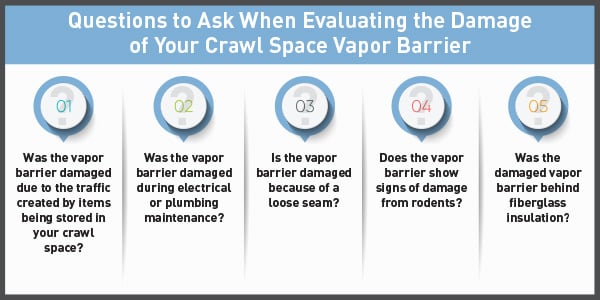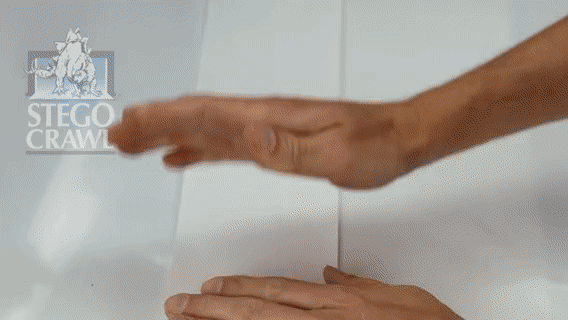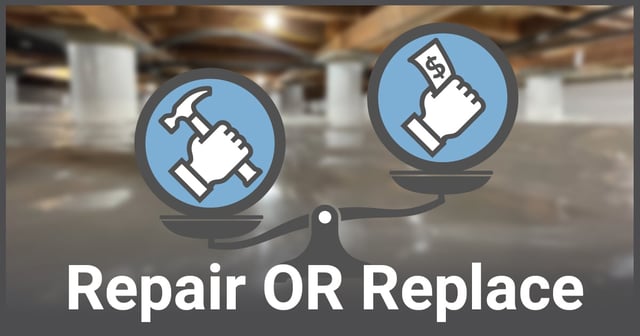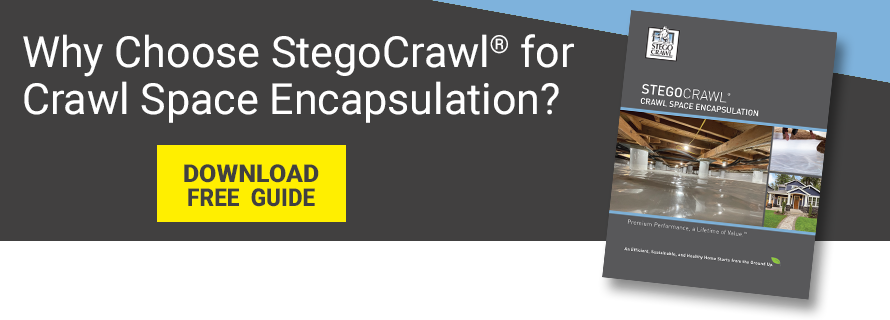Should You Repair or Replace Your Damaged Crawl Space Liner?
Weigh Your Options Before Committing to Your Next Home Improvement Project
Are you wondering what your next home improvement project should be? A lot of homeowners spring for aesthetic upgrades when the biggest bang for your buck may come from your crawl space. Frequently an afterthought, fixing your crawl space can help ensure a safe structural foundation and great indoor air quality to complement many other home upgrades you may be considering.
If you already have a vapor barrier installed in your crawl space, then you may notice the role it plays in preventing moisture build-up and lowering energy bills in your home. But what do you do if your vapor barrier is showing signs of damage? Do minor cuts or punctures need to be patched? Does the existence of a larger damaged area or low-quality performance of your current product suggest it might be time to replace your current system with a sturdier, better-quality vapor barrier? These are the questions to ask yourself when deciding whether to simply repair or completely replace your existing crawl space vapor barrier.
When to Repair a Crawl Space Vapor Barrier and How to Do It
Repairing your vapor barrier might be as easy as applying a few patches to punctures or retaping loose seams. But before you get out the tape, it’s important to make sure you are properly equipped. Here are the proper steps to follow when repairing your crawl space vapor barrier:
- Is the vapor barrier an ASTM E1745 compliant material? This industry standard for plastic vapor retarders used under concrete slabs requires the materials to undergo conditioning testing designed to simulate in-service (under-slab and installation) conditions, and it classifies vapor retarders based on their tensile strength, puncture resistance, and water vapor permeance ratings. Although (in most cases) your crawl space liner will never have a concrete slab on it, the thresholds outlined in ASTM E1745 set reasonable and cost-effective thresholds that should be adhered to when selecting your crawl space barrier. If the answer is no, then most likely no amount of money and effort you spend repairing the vapor barrier will be worth it. Generic poly (or other non-ASTM E1745 materials) is typically a sieve to moisture and no amount of lipstick will dress that pig up. Stay tuned as I discuss replacing a crawl space liner later on in the article. If the answer is yes…
- Clean and inspect the area: Inspect for dirt and debris and ascertain the exact nature of the problems. Evaluating the cause of damage, such as tears or adhesion problems, will be important in knowing what steps to take in the future.

Some of the questions to ask when evaluating the damage of your vapor barrier are:
- Is the vapor barrier in question being damaged due to the traffic created by items being stored in your crawl space (moving boxes around, snagging on sharp edges, etc.), or perhaps during electrical or plumbing maintenance? If that’s the case, you may want to forego repairs and start over with a high-quality vapor barrier material that you don’t have to treat so delicately (something with higher puncture resistance test results). If you do have a weak vapor barrier that you don’t plan to replace, make sure to move boxes or stored items with sharp edges away from the surface of your crawl space liner to prevent further punctures or tears.
- Was it just a loose seam? Make sure the tape you’re using was designed for crawl spaces and designed to stick specifically to the plastic liner you’ve installed. If you’ve got the wrong tape, you’ll likely end up back in your crawl space every so often re-taping seams. A slick plastic tape with the wrong type of adhesive may continue to spell adhesion trouble. Refer to this blog article for helping you select the right kind of seaming tape for the job.
- Was it behind fiberglass insulation? Even if a vapor barrier is concealed behind insulation, a tear will still compromise its effectiveness. Fiberglass insulation is not adequate moisture protection; risks of mold, rot and structural decay can persist if the crawl space is not properly protected from moisture.
- Does it show signs of damage from rodents? Small animals can use a crawl space to build a nest or hide out in the winter months, and this may involve burrowing through the vapor barrier. If you find a tear that you suspect was made by a pest, you should investigate the entire vapor barrier perimeter to ensure that they have not damaged other areas that are less easily seen. In addition to repairing the vapor barrier with patches, you may need to consult an exterminator.
- Follow the manufacturer’s installation instructions: For example, patched areas typically require a material that spans 6” on all sides of the tear to ensure vapor can’t migrate through the new seam you’re creating. Following the instructions is imperative to returning the vapor barrier in your crawl space to an effective system.
Getting ready to install your crawl space liner? Check out our video that provides a step-by-step guide on how to install your crawl space vapor barrier.

Benefits of Replacing with a High-Quality Liner
There are two reasons you might want to consider replacing your vapor barrier instead of simply repairing it. Either it is damaged beyond repair and a replacement will save you time and money, or you realize that repairing a cheap vapor barrier is ineffective and you want a more secure moisture protection system.
If your vapor barrier is made of a thin, generic type of 6-mil polyethylene (often called “visqueen”), simply repairing it is unlikely to be enough. These low-end materials often have a high permeance and offer very little moisture protection. On the other hand, a vapor barrier with increased tensile strength, puncture resistance, and lower permeance (high permeance = bad moisture protection) can provide the following benefits:
- Better moisture control: Inexpensive poly blends of vapor barrier typically have very high permeance ratings that allow moisture to migrate through them, creating a muggy, humid environment in your crawl space. No matter how thick your crawl space liner is, you want to make sure it has a very low permeance rating.
- Reduced HVAC costs: Less moisture in your crawl space means less moisture migrating into the living spaces of your home, easing the strain on your HVAC system. If your HVAC system isn’t constantly having to condition humid air, you can save on your energy bills.
- Resistance to future damage: A barrier composed of a material that has been subjected to conditioning testing and maintains a low permeance rating will likely last longer than your average, generic plastic sheeting materials, which are not typically designed to handle moisture protection applications.
As a homeowner, you know that home improvement projects are necessary to keep your home beautiful, comfortable, and energy-efficient. While it might not be as visible as other areas of your home, your crawl space needs attention every now and then too. A high-quality crawl space liner will stand the test of time and allow you to enjoy the comfort of a moisture-controlled home and lower energy bills any time of year.

Written by Tom Marks
Tom Marks is the Business Development Project Manager with Stego Industries, LLC. He has been with Stego since 2007, serving many years as the Rocky Mountains Regional Manager. Now, his focus is geared toward vapor barrier solutions for new and existing homes as the Product Manager of the StegoHome and StegoCrawl brands. In addition, Tom serves as Sustainability Manager, overseeing Stego’s leadership in holistic product and corporate sustainability. Tom enjoys working with a wide range of project team members and customers to incorporate effective sub-slab vapor protection and create healthy, sustainable homes and buildings.
- Stego (26)
- StegoCrawl (24)
- Stego-Awareness (17)
- StegoHome (15)
- Case Studies (14)
- StegoCrawl-Consideration (12)
- StegoCrawl-Awareness (11)
- Customer Stories (9)
- Stego-Consideration (9)
- Pango (8)
- StegoHome-Consideration (8)
- Beast (7)
- How to Install (7)
- StegoHome-Awareness (7)
- Drago (5)
- Pango-Awareness (5)
- Beast-Awareness (4)
- Beast-Consideration (3)
- Drago-Awareness (3)
- Pango-Consideration (3)
- Stego IQ (3)
- Drago-Consideration (2)
- StegoCrawl-Decision (2)
Popular Posts
Stay Connected.
Enter your email below.









Post Comments